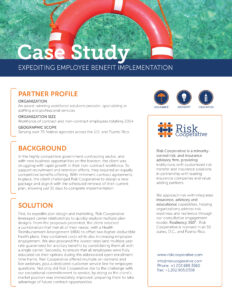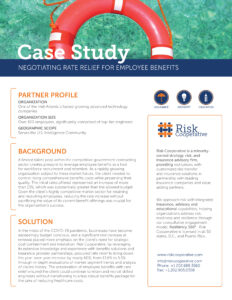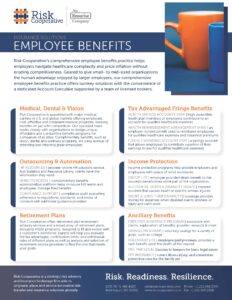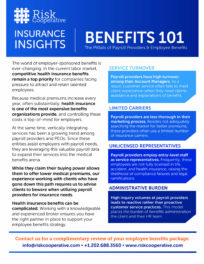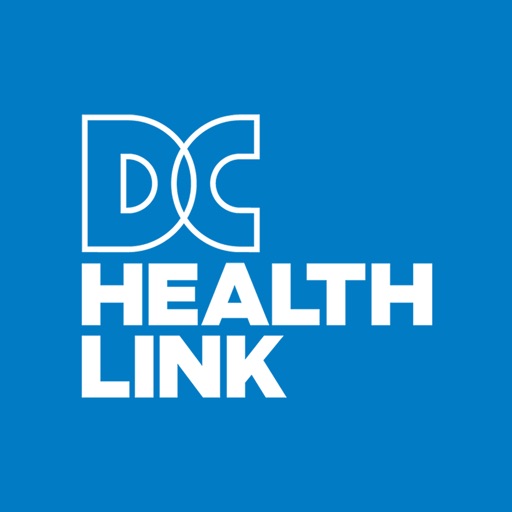Insurance Solutions
Comprehensive Employee Benefits
Risk Cooperative’s comprehensive employee benefits practice helps employers navigate healthcare complexity and price inflation without eroding competitiveness.
Geared to give small- to mid-sized firms the human advantage enjoyed by larger employers, comprehensive employee benefits offer turnkey solutions with the convenience of one point of contact.
Employee Benefits:
Compliant Healthcare
Risk Cooperative is appointed with major medical carriers in U.S. and global markets offering employers cost-effective and compliant medical programs, keeping benefits on par with competition. Our specialist team works closely with organizations to design unique, affordable and competitive benefits programs for companies of all sizes.
Dental, Vision, Wellness
Offering complimentary benefits, such as vision, dental and wellness programs, are a key avenue of attracting and retaining great employees.
Outsourcing and Automation
From payroll processing to automated benefits and employee administration tools, Risk Cooperative offers a suite of compliant solutions, freeing up HR teams to pursue higher value-added projects.
Income Protection
Group life, disability and innovative income protection programs help provide employers and employees with peace of mind worldwide.
Retirement Plans
Risk Cooperative offers a broad array of retirement plans, including 401(k) programs, designed to fit and evolve with a customer’s workforce.
Voluntary Benefits
A suite of voluntary, employer-sponsored programs is available, designed to reduce employee contributions while driving up engagement and loyalty.
Resource Library
Ultimately, at every level of the healthcare supply chain – insurance carriers, benefits brokers, providers, employers, and end-users – we all need to be creative about ways to contain costs while still supporting health and wellness. So, how can a health insurance carrier provide you with solutions that bring competent and quality healthcare to your employees?
Rising Costs
Employers and employees alike rank health-related benefits as the most important offered – more than paid leave, financial incentives, and retirement planning – and this value is shown in a positive ROI. In 2022, employer sponsored insurance (ESI) drove $275.6 billion in improved productivity, $101 billion reduction in direct medical costs, and $119.2 billion in tax benefits. Additionally, post-pandemic changes to health-related employee benefits include adding valuable services like telemedicine (93% of surveyed organizations) and mental healthcare (91%).
Healthcare costs have outpaced rates of inflation for decades, and we’re expecting this growth to continue, ultimately totaling nearly 20% of the U.S. economy by 2029. Data from the Centers for Medicare and Medicaid Services (CMS) indicate an increase in health spending tripled between 2000 and 2022 to $4.5 trillion. While multiple factors contribute to this growth, often cited are an aging population, labor pressure, and new high-cost prescription drugs.
In fact, we can see the cost of care increases reflected in the rising insurance costs over time with the average per-employee cost reaching a record high in 2023. Developments in the pharmaceutical market are apparent, with the pharmacy benefit cited as the fastest growing component of plan cost. Large employers have been mitigating these increases by increasing deductibles and out-of-pocket maximums, but this trend is difficult for the mid-size businesses to manage, as they’re subject to certain regulations but tend to have less ability to allocate additional resources to their employee benefits package.
What is Max Performance Plus?
Carefirst launched Max Performance Plus on June 1, 2024 as an add-on to a fully insured benefit that allows employers to receive a surplus of net-billed premium not used over the plan year. It’s essentially a funding mechanism that allows you to take a fully-insured product and adds the potential to receive 100% of the surplus, up to 15% of the net premium, at the end of the contract period.
The Max Performance Plus program carries a higher risk premium charge (a.k.a. retention item) and can be sold with any fully-insured Carefirst medical or prescription drug plan. It’s not a separate plan, it’s an add-on to the Carefirst fully-insured product portfolio. While you cannot cancel mid year, you can opt to remove the Max Performance Plus product at renewal and still continue with your fully-insured plan.
In contrast to a self-insured product, Max Performance Plus takes your current fully-insured product and adds a performance element. Many groups want to know how they are performing as a group. By adding Max Performance Plus, employers get the reporting function for more information about performance, while getting surplus back as a payment.
Remember, with a self-insured plan, the employer pays claims beyond what insurance will cover, up to a pre-set amount. Performance reporting allows groups to track that claim activity. Mid-size groups 50-150 employees are often not able to take full advantage of all of the self-insured product’s benefits, and these plans calculates surplus potential as a percentage of an administrative credit.
Surplus Payment
It typically takes 60-110 days to finish paying claims after the end of the plan year. At that point your surplus payment is given as a check or electronic funds transfer – not just a premium credit. Groups are eligible to receive their surplus payments as long as they remain in a fully-insured product with Carefirst and have paid in full – even if they decide not to renew the Max Performance Plus program. Deficits do not affect the surplus payment, nor do they carry forward.
Reporting
Groups of 51-99 employees using this program will have access to monthly reporting features they wouldn’t otherwise have on a fully-insured plan; Executive Summary and Account Experience Reports are easily access via the employer portal under Account Insights. Larger groups, which previously had access to reporting, will also see additional performance data around demographics, cost analysis, utilization, site of care, high-cost claimants and pharmacy use. The reporting data gives employers information that can help inform and educate employees about more cost-effective healthcare choices, such as the value of in-network providers and avoiding expensive ER visits for urgent care needs.
Risk Cooperative Grows Employee Benefits Practice with Industry Recognized Team Washington, D.C. – Risk Cooperative, a certified minority business enterprise specializing in insurance brokerage and risk advisory services, announces a prestigious industry award and Employee Benefits staffing transitions amidst continued business growth. Derrick Wong, who joined Risk Cooperative in 2019 as an Account Executive and […]
Risk Cooperative Grows Employee Benefits Practice with Industry Recognized Team
Washington, D.C. – Risk Cooperative, a certified minority business enterprise specializing in insurance brokerage and risk advisory services, announces a prestigious industry award and Employee Benefits staffing transitions amidst continued business growth. Derrick Wong, who joined Risk Cooperative in 2019 as an Account Executive and transitioned to leading the firm’s Employee Benefits Practice in 2022, has been named a 2023 Power Broker by Risk & Insurance, affiliated with The Institutes.
This is the 19th year that Risk & Insurance has celebrated individual brokers for exceptional client work, and the Employee Benefits category boasts a particularly crowded field of industry talent. “Derrick could not be more deserving of this industry recognition,” says Andres Franzetti, Risk Cooperative’s Co-Founder and CEO. “He has demonstrated excellence in every facet of his role here, driving 100% client retention with top-notch customer service, while also leading our Employee Benefits business development strategy to great success.”
“While we broker Employee Benefits for firms across multiple industry verticals, we’ve really seen traction with government contractors, technology focused professional services firms, and nonprofit organizations. Familiarity with their specific challenges makes us the best broker to serve these clients,” Mr. Wong says. “That’s why we’re seeing such high growth, client retention and referral numbers.” Concurrent with Mr. Wong’s recognition, Beverly Simms has emerged as an exceptionally talented Account Executive in the Employee Benefits Practice. Ms. Simms joined the firm in 2021 as an Account Manager and quickly demonstrated her talent for exceeding client service expectations. To meet the sustained growth and service needs of our customers, Risk Cooperative is also pleased to announce the hiring of Amanda Flowers, as our newest Account Manager in the Employee Benefits Practice.
Economic uncertainty scuttled many firms’ business development plans over the last 2-3 years, leading high-profile brokerages to be pessimistic about 2023. While circumstances forced the insurance industry at large to adapt to shifting realities, Risk Cooperative was able to simply capitalize on their knack for innovation, which has been central to the firm since its founding in 2014 by a team of seasoned risk and insurance executives. Now in its 9th year of business and licensed in all 50 states, D.C. and Puerto, Risk Cooperative is globally recognized in the fields of enterprise risk management, emerging risks, global insurance solutions, and operational resiliency.
“Our MBE certification, and staff expansion have positioned our firm for continued success in 2023,” says Mr. Franzetti. “Derrick’s Power Broker Award confirms the industry’s recognition that Risk Cooperative is doing outstanding work in servicing our clients and the firm continues to make strides as a powerhouse firm in the marketplace.”
***
About Risk Cooperative
Risk Cooperative is an independent and certified minority-owned insurance brokerage and risk advisory firm. Licensed in all 50 states, D.C. and Puerto Rico, Risk Cooperative helps organizations address risk, readiness and resilience across all classes of risk – including comprehensive employee benefits, life and health, property and casualty, cyber and other specialty lines. Appointed with all major carriers and the Lloyd’s of London market, we place domestic and international insurance solutions to help meet clients’ needs.
About Risk & Insurance, Affiliated with The Institutes
Risk & Insurance® covers the people, stories and risks that embody the essential functions of risk management and commercial insurance. Power Broker designations are based on nominations provided by brokers and judged based on references given by risk managers. Judging is based on a nominee’s creativity in problem solving, industry knowledge and client service. To review the complete list of 2023 Power Brokers, visit Risk & Insurance.
media@riskcooperative.com | 202-688-3560
The Great Resignation, where roughly 33 million Americans have left their jobs in the past year, has caused employers to change how they structure the work environment to improve employee satisfaction in their work and life.
Key takeaways:
Work from Home | Even as WFH has become the norm, some employees are opting to live an international lifestyle while working remotely. Employers who embrace flexible schedules and telework will be more competitive in this job market.
Empowerment is Key | Monetary incentives are simply not enough. Organizations need to foster employee empowerment and one way to do that is to ensure that the scope of employee benefits is aligned with a healthy work/life culture.
Take a Temperature Check | Get a read on your employee satisfaction with a mid-year check-in. Addressing concerns to retain talent is far more cost effective than onboarding new employees.
Our Attitude Makes a Difference | With an epidemic of mental health challenges exacerbated by current events, access to wellness and mental health services is key to an engaged, productive workforce. Ensuring appropriate services are available and that employees are educated about them goes far in promoting a positive employee relationship.
In our How to Choose Your Broker on-demand webinar, our experts share insider tips on what great brokers do to arm their clients with the information they need to serve their employees and protect their businesses. They cover: Best practices for broker/client communications What your broker can do to save you money on employee benefits […]
In our How to Choose Your Broker on-demand webinar, our experts share insider tips on what great brokers do to arm their clients with the information they need to serve their employees and protect their businesses. They cover:
- Best practices for broker/client communications
- What your broker can do to save you money on employee benefits
- Resources your broker can offer to support regulatory compliance
- How your broker can help you manage the administration of your benefits package
- The value of utilizing a broker that can handle all lines of insurance
- How a broker can help address risk across business operations
- Questions about pandemic resiliency and recovery
It can be quite costly – in time, money, and opportunity – to stay with a broker that’s not meeting your expectations. Despite what many businesses fear, changing brokers doesn’t have to be difficult.
Additional Supporting Content
Making Your Broker Selection | Optimize Your Broker Partnership | What Coverages Are Needed, And When
Have questions? Send us a message.
The global pandemic has changed workplaces throughout the U.S., placing a spotlight on employers to reevaluate their benefits policies and offerings. The increasingly competitive market for talent requires businesses to use more than salary to attract and retain skilled professionals.
Employers are finding employee benefits packages to be a powerful tool for employee recruitment and retention.
Auxiliary benefits—those that go beyond medical, vision and dental coverages—can have an outsize impact relative to their cost. Providers often additional incentives to bundle several of these benefits together.
Income or job loss due to a short or long-term disability can be financially devastating, but insurance can provide employees with security and financial protection. According to the U.S. Bureau of Labor Statistics, the cost of providing short and long-term disability insurance is approximately one percent of total compensation costs.
There is still uncertainty with the long-term effects of the coronavirus (COVID-19), alongside an increasing understanding that another pandemic is likely to occur in the future. Offering short-term and long-term disability insurance to employees provides the security and financial protection to ease some of that concern.
The Importance of Short-Term and Long-Term Disability Insurance
Disability benefits provide a form of income replacement and financial security to employees who are unable to work due to a non-job-related illness or accident. The pandemic has many employers and employees focusing on the illness aspect of disability insurance, and it is important to note that insurance carriers evaluate COVID-19 as any other medical condition.
Short-term disability benefits can cover illness from COVID-19 if an employee is unable to work because of a verified medical condition. Employees who are unable to see an in-person physician due to social distancing can typically obtain medical verifications through virtual visits with medical professionals. To assist with mitigating the stress of claiming short-term disability during a pandemic, some insurance carriers are waiving the elimination period (waiting period) for employees who are medically diagnosed with COVID-19.
Short-term disability benefits typically only cover a few months. For employees who no longer can work for an extended period (sometimes until the age of retirement), long-term disability works in tandem with short-term disability to ensure there is no gap in coverage; providing a broader protection and safety net for employees and their families. The uncertain long-term effects of COVID-19 places an increased importance on long-term disability benefits. Fortunately, long-term disability benefits offer financial protection if an employee sustains a serious illness, such as a chronic respiratory disease after dealing with COVID-19.
Common short-term disability claims include:
-
- Pregnancies
- Bone and muscle disorders affecting the back, spine, knees, hips, and other body parts
- Digestive disorders
- Mental health issues including depression and anxiety
Common long-term disability claims include:
-
- Osteoarthritis
- Cancer
- Cardiovascular and circulatory disorders (heart attack, coronary artery disease)
- Injuries such as fractures, sprains, and strains of muscles and ligaments
Mental Health is Priceless
Some insurance carriers offer an Employee Assistance Program (EAP) at no additional cost to employers who provide short-term and long-term disability benefits to their employees. EAPs connect employees with confidential, professional specialists to assist with managing and improving mental health issues.
The importance of EAPs has become more prevalent amongst employers with the heightened need to help employees cope with the uncertainty of a global pandemic.
Life Insurance: Preparing for the Future
The global pandemic is a sobering reminder that our health is not guaranteed. Thankfully, there are no life insurance policy exclusions regarding pandemic events such as COVID-19. Some insurance companies even provide bundle discounts and extended rate guarantees for employers offering life insurance with short-term and long-term disability insurance. Offering these types of benefits as an employer not only demonstrates a sense of mindfulness and appreciation for its workforce, it also establishes a solid foundation of financial preparedness for potential risks in the future.
Ancillary Benefits | Resource Library


